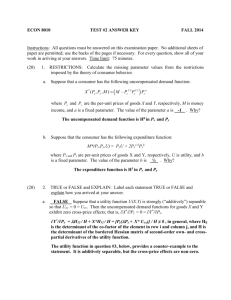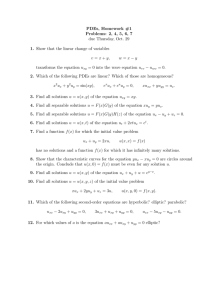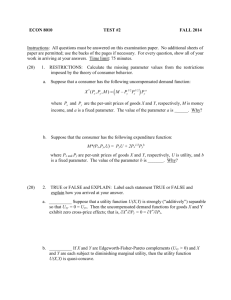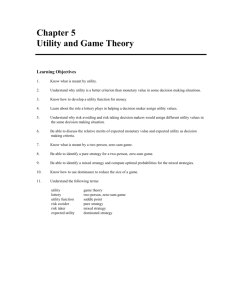ECON 8010 TEST #2 SOLUTIONS FALL 2015 Instructions: All
advertisement
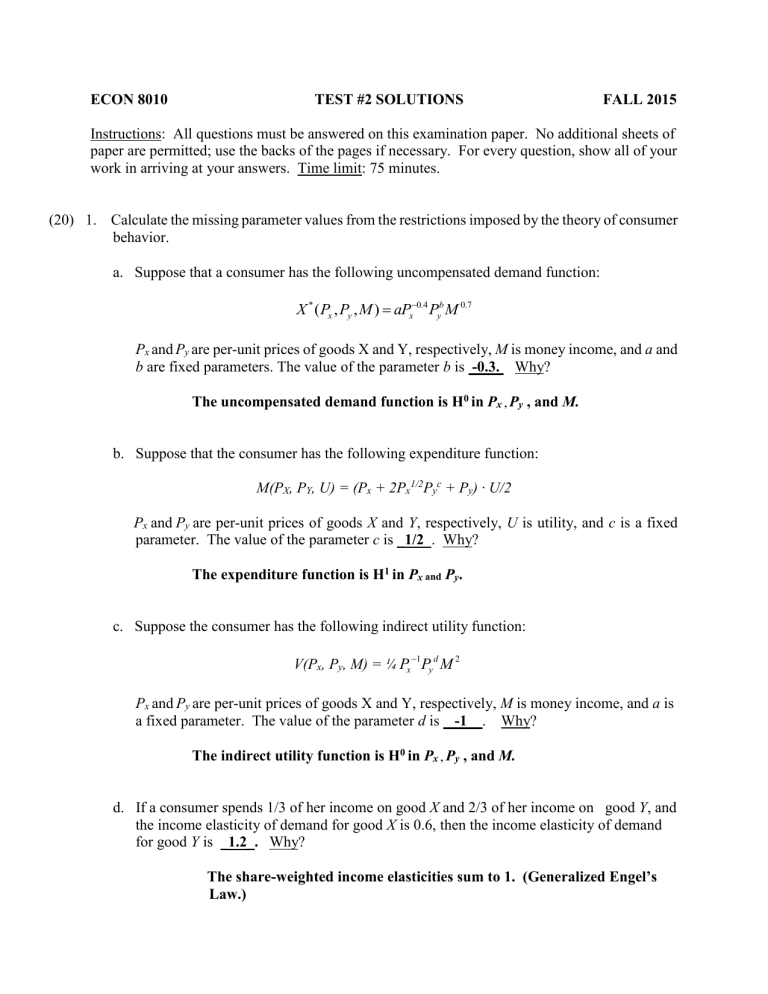
ECON 8010 TEST #2 SOLUTIONS FALL 2015 Instructions: All questions must be answered on this examination paper. No additional sheets of paper are permitted; use the backs of the pages if necessary. For every question, show all of your work in arriving at your answers. Time limit: 75 minutes. (20) 1. Calculate the missing parameter values from the restrictions imposed by the theory of consumer behavior. a. Suppose that a consumer has the following uncompensated demand function: X * ( Px , Py , M ) aPx0.4 Pyb M 0.7 Px and Py are per-unit prices of goods X and Y, respectively, M is money income, and a and b are fixed parameters. The value of the parameter b is -0.3. Why? The uncompensated demand function is H0 in Px , Py , and M. b. Suppose that the consumer has the following expenditure function: M(PX, PY, U) = (Px + 2Px1/2Pyc + Py) ∙ U/2 Px and Py are per-unit prices of goods X and Y, respectively, U is utility, and c is a fixed parameter. The value of the parameter c is _1/2 . Why? The expenditure function is H1 in Px and Py. c. Suppose the consumer has the following indirect utility function: V(Px, Py, M) = ¼ Px 1Py d M 2 Px and Py are per-unit prices of goods X and Y, respectively, M is money income, and a is a fixed parameter. The value of the parameter d is _ -1__. Why? The indirect utility function is H0 in Px , Py , and M. d. If a consumer spends 1/3 of her income on good X and 2/3 of her income on good Y, and the income elasticity of demand for good X is 0.6, then the income elasticity of demand for good Y is _1.2_. Why? The share-weighted income elasticities sum to 1. (Generalized Engel’s Law.) (20) 2. TRUE or FALSE and EXPLAIN: Label the statement TRUE or FALSE and briefly explain how you arrived at your answer. a. FALSE Suppose that a utility function U(X,Y) is strongly (“additively”) separable so that Uxy = 0 = Uyx. Then the uncompensated demand functions for goods X and Y exhibit zero cross-price effects; that is, ∂X*/∂Py = 0 = ∂Y*/∂Px. ∂Y*/∂Px = H12 / H + X*H32 / H = [Py(Px + X* Uxx)] / H ≠ 0 , in general, where Hij is the determinant of the co-factor of the element in row i and column j, and H is the determinant of the bordered Hessian matrix of second-order own- and cross-partial derivatives of the utility function. The utility function in question #3, below, provides a counter-example to the statement. It is additively separable, but the cross-price effects are non-zero. b. TRUE_ If X and Y are Edgeworth-Fisher-Pareto complements (Uxy > 0) and X and Y are each subject to diminishing marginal utility, then the utility function U(X,Y) is quasiconcave. Quasi-concavity ↔ Ux2 Uyy – 2Ux Uy Uxy + Uy2 Uxx < 0 Assuming complementarity (Uxy > 0) and diminishing marginal utility in both X and Y (Uxx < 0, Uyy < 0), along with monotonicity (Ux > 0, Uy >0), we have Ux2 Uyy – 2Ux Uy Uxy + Uy2 Uxx < 0 (–) (+) (+) (+) (–) c. TRUE If the utility function U(X,Y) is additively separable and both X and Y exhibit diminishing marginal utility, then both X and Y are normal goods." ∂X*/∂M = – (– UXY ·PY + UYY · PX)/H and ∂Y*/∂M = (– UXX ·PY + UYX · PX)/H where H > 0 is the determinant of the bordered Hessian matrix. Since additive separability implies UXY = UYX = 0, and diminishing marginal utility implies UXX < 0 and UYY < 0, we have ∂X*/∂M = – (UYY · PX)/H > 0 and ∂Y*/∂M = (– UXX ·PY)/H > 0 d. TRUE. In a model with three goods (X, Y, and Z), if Y and Z are net complements then X and Z are net substitutes. S ∙ p = 0 where S is a 3x3 singular, symmetric matrix of own- and cross- substitution terms, and p > 0 is a 3x1 vector of prices. In the third row of S, S ∙ p = Szx ∙ px + Szy ∙ py + Szz ∙ pz = 0. Szz < 0 by negativity of the own-substitution effect and Szy = Syz < 0 by the assumption that Y and Z are net complements, so it must be true that Szx = Sxz > 0 and, therefore, X and Z are net substitutes. (20) 3. Suppose that an individual maximizes the utility function U(X,Y) = Y – X -1 subject to the budget constraint M = Px X + Py Y. a. Derive the uncompensated demand functions for X and Y. ʆ = Y – X -1 + (M – Px X – Py Y) ∂ʆ/∂X = 1/X2 – Px = 0. ∂ʆ/∂Y = 1 – Py = 0. MRSy,x = Ux/ Uy = (1/X2)/1 = 1/X2 = Px/Py X = (Py/Px)1/2 ∂ʆ/∂ = M – Px X – Py Y = 0 M = Px X + Py Y M = Px [Py/Px)1/2]+ Py Y Y* = [M – (Px Py) ½]/Py X* = (Py/Px)1/2 b. Is either X or Y an inferior good? Justify your answer rigorously. No. ∂Y*/∂M = 1/Py > 0 ∂X*/∂M = 0 (10) 4. Assume that an individual's preferences are given by the indirect utility function V ( Px , Py , M ) [( Px1/ 2 Py1/ 2 ) 2 ] / M Use Roy's Identity to derive the uncompensated demand functions for X and Y. ∂V/∂Px = ( ̶ 2/M) ( Px1/2 Py1/2 ) (1/2 Px ½) ∂V/∂Px = ( ̶ 2/M) ( Px1/2 Py1/2 ) (1/2 Py ½) ∂V/∂M = (1/M 2) ( Px1/2 Py1/2 ) 2 X*(Px , Py , M) = ̶ ∂V/∂Px / ∂V/∂M = M / [ ( Px1/2 Py1/2 ) Px1/ 2 ] = M / [ Px + (Px Py) ½] X*(Px , Py , M) = ̶ ∂V/∂Py / ∂V/∂M = M / [ ( Px1/2 Py1/2 ) Py1/2 ]= M / [ Py + (Px Py) ½] (15) 5. Suppose an individual’s preferences are given by the expenditure function M*(Px, Py, U) = 2Px1/2Py1/2 + PyU a. Derive the compensated demand functions for X and Y. Xc*(Px,Py,U) = ∂M*/∂Px = Px - ½ Py ½ = (Py / Px) ½ Yc*(Px,Py,U) = ∂M*/∂Py = U + Px ½ Px - ½ = U + (Px / Py) ½ b. What is the (direct) utility function? U[Xc*(Px, Py, U), Yc*(Px, Py, U)] = Yc* – (Xc*) -1 U(X,Y) = Y – X -1 (15) 6. Suppose that an individual’s preferences are represented by the utility function U( x, ) = x , where x denotes units of a consumption good, is time spent at leisure, and > 0 is a fixed parameter. She works h = T – hours per week at an hourly wage of w, and the per-unit price of x is normalized to p = 1. Her total weekly income is the sum of labor income (w·h) and non-labor income I. a. Derive her labor-supply function h*(w,I; ,T). Substitute x = w·(T – ) + I into U( x, ) = x and solve max U( ) = [ w·(T – ) I ] The F.O.C. is ∂U/∂ = w·T – 2·w· + I + = 0 Solving for * (w,I; ,T), we have * (w,I; ,T) = (w·T + I + ) / 2·w or T – * (w,I; ,T) = h*(w,I; ,T) = (w·T – – I) / 2·w = T/2 – [(I + ) / 2w] b. Rigorously analyze the effect of an increase in the wage rate on her labor supply. ∂ h*/∂w = [T·2·w – (w·T – – I)·2] / 4w2 = (I + ) / 2w2 > 0 ~ ) such that c. An individual’s reservation wage is defined as the value of w (denoted by w ~ (I; ; T). h*(w, I; , T) = 0. Derive her reservation-wage function w Set h*(w,I; ,T) = (w·T – – I) / 2·w = 0 and solve for w: ~ (I; ,T) = (I + ) / T w
